Many think of optics when selecting a telescope, but having the proper mount is also quite important. A good telescope mount securely holds the telescope, points it, and does so without vibration. Modern mounts today often feature computerized pointing systems with built-in astronomical databases. There are three different types of mounts for telescopes:
Altazimuth Telescope Mounts
Alt-azimuth mounts, also called alt-az mounts, feature two axes of motion for the telescope. The up-and-down motion is called the altitude (or declination), and the back-and-forth or side-to-side motion is called the azimuth (or right ascension). Altazimuth mounts are commonly found on refractor telescopes and some compound telescopes.
The advantage of altazimuth mounts is that they are relatively inexpensive. The disadvantage is that they are not suitable for tracking the movement of objects across the night sky.
Dobsonian Telescope Mounts
A specialized form of alt-azimuth mount is the Dobsonian mount, which is almost exclusively used with larger Dobsonian reflector telescopes. Dobsonian mounts are easy to spot as they sit low to the ground, are made typically of wood, and feature a wide base at the bottom.
The advantages of Dobsonian mounts are that they are very cheap and simple to make and are exceptionally stable. The disadvantages are that they are relatively heavy and awkward to transport and like all alt-azimuth mounts, aren't really suitable for tracking the motion of objects.
The latter shortcoming can be overcome with a Poncet platform, which allows one to track the telescope for a relatively short period of time (an hour or so) before resetting the mechanism.
Equatorial Telescope Mounts
Equatorial mounts, also called EQ mounts, are more complex and expensive than alt-azimuth mounts. In addition to declination and right ascension axes of motion, a telescope on an equatorial mount can track objects across the sky using the mount's polar axis. To do so, telescopes on equatorial mounts must be aligned properly before use - called polar alignment. Polar alignment entails pointing the telescope toward the North Celestial Pole.
The great advantage of an equatorial mount is that it is ideal for astrophotography as the object being viewed will stay in the center of the eyepiece indefinitely.
The most common type of equatorial mount is the German equatorial mount. Other types of EQ mounts more commonly found on large telescopes at observatories include the horseshoe mount, English mount, crossed axes mount, and form mount.
Find your inner astronomer. Your complete guide to amateur astronomy.

